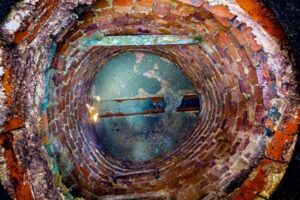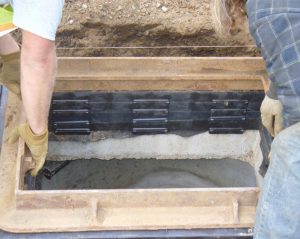Infiltration and Inflow in Manholes:
Causes and Solutions
Wastewater infiltration and inflow (I&I) in manholes often present significant challenges in sewer system maintenance for municipalities. Domestic wastewater, industrial wastewater, and storm water runoff can all contribute to I&I, but it is the infiltration and inflow caused by wastewater that is particularly troublesome.
What is wastewater?
Wastewater is perhaps the most important water resource that we have as humans. It is being used every day, yet most people do not know its value and importance. In just one year, wastewater production has doubled to nearly 6 billion tons. Wastewater comes from the water from your kitchen, bathroom, and laundry. It can also include rainwater runoff in a manhole sewer structure. Recently, wastewater has become more significant than ever before.
What is Wastewater Infiltration and Inflow:
Wastewater (I&I) Infiltration and Inflow causes excessive flows and overloading of sewers, treatment facilities, and pump stations during wet weather. Infiltration occurs when groundwater enters manholes through joints, cracks, and defects in manhole walls. Inflow happens when storm water and other surface runoff enter the sewer system through foundation drains, roof leader connections, and other sources of direct entry. Wastewater I&I can reduce sewer system capacity, increase operational costs, and lead to unsanitary sanitary sewer overflows (SSOs).
Of all the parts that comprise the I&I process; the chimney section is arguably the most challenging to maintain. This is caused by its multi-functionality, which prevents maintenance from being performed as frequently as other sections. This can lead to unexpected damage such as clogging and cracks. When this happens, wastewater will begin to seep into your sewer pipes and can affect the overall health of your city’s water. Because the chimney section is so difficult to control, cities will be susceptible to several health issues. In-pipe Inspection and Irrigation is part of maintaining a wastewater collection system. When the I&I debris goes down the manhole, it obstructs the flow of storm water and damages the underground pipes. This could also ultimately cost extra money for the city.

The Causes of Wastewater I&I In manholes:
Many factors can contribute to wastewater I&I in manholes. Some of the most common causes include:
• Aging and decaying infrastructure
• Poor construction practices and materials selection
• High groundwater tables
• High volumes of surface runoff
• Deterioration of materials due to root infiltration and seismic activity
• Improper maintenance of the sewer system
The Effects of Wastewater I&I on the Sewer System:
Wastewater I&I in manholes can create many operational and cost problems for municipalities. Some of the most notable effects of wastewater I&I include:
• Increased wastewater treatment costs due to overloading of treatment facilities
• Unscheduled maintenance and repairs, including replacing damaged pipes, pumps, and other equipment.
• Damage to infrastructure due to corrosion, sewer overflow, and other factors
• Increased public health risks due to overflows of untreated wastewater.
Solutions to Wastewater I&I
Many factors can help municipalities effectively manage wastewater I&I. Some of the most effective solutions include:
• Comprehensive inspection programs to find and repair damaged infrastructure.
• Rehabilitation of existing infrastructure to improve its performance.
• Implementation of a proper manhole maintenance program
• Education programs to inform the public about the importance of reducing wastewater I&I in residential and industrial areas.
Conclusion:
Wastewater I&I in manholes is a significant and costly issue for municipalities. It is essential to find a comprehensive solution that can manage the problem effectively. With proper inspection, rehabilitation, maintenance, and public education programs, municipalities can significantly reduce the impact of wastewater I&I and improve the performance of their sewer systems.
Determining the exact percentage of infiltration and inflow (I&I) specifically from chimney sections in manholes can be challenging due to variations in sewer system design and conditions. However, it is widely recognized that chimney sections can contribute a significant portion of I&I in manholes.
Chimney sections, also known as risers or shafts, are vertical components of manholes that provide access to underground sewer lines. These sections are typically constructed using multiple precast concrete rings stacked on top of each other. The joints between these rings, as well as any cracks or defects in the concrete, can serve as entry points for groundwater and stormwater runoff.
The exact percentage contribution of chimney sections to I&I can vary depending on several factors such as the age and condition of the manholes, the groundwater table level, and the prevalence of storm events. In some cases, it is estimated that chimney sections can account for approximately 20-30% or even more of the total I&I in a particular sewer system.
To assess the precise percentage of I&I coming from chimney sections in a specific manhole or sewer system, advanced flow monitoring techniques, such as flow meters or flow isolation devices, are often used. These methods can help quantify the amount of flow entering through chimney sections compared to other potential sources of I&I.
It is important to note that addressing the I&I issues associated with chimney sections requires proper inspection, maintenance, and repair. Sealing joints, repairing cracks, and improving the overall integrity of chimney sections through rehabilitation measures play a crucial role in minimizing I&I contributions.
While the exact percentage may vary, it is evident that chimney sections can be a significant source of wastewater I&I in manholes. Municipalities and sewer system operators should prioritize identifying and addressing the issues related to chimney sections to reduce I&I and improve the overall performance of the sewer system.
The manhole section is one of the main causes of wastewater impairment.
Wastewater intrusion is costly and there are lots of different variables, but I&I in manhole chimney sections is the most crucial part of maintaining a wastewater collection system. The percentage of the cost for a city to process the extra I&I from the manhole would be better spent on other projects.


